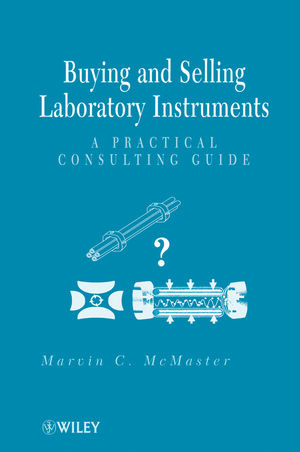Buying and Selling Laboratory Instruments: A Practical Consulting GuideISBN: 978-0-470-40401-0
Hardcover
176 pages
July 2010
 This is a Print-on-Demand title. It will be printed specifically to fill your order. Please allow an additional 10-15 days delivery time. The book is not returnable.
|
||||||
PART ONE PURCHASING LABORATORY INSTRUMENTS.
1 Selecting Laboratory Instruments.
1.1 Modular Systems.
1.2 Systems-in-a-Box.
1.3 Automation.
1.4 Data Archival and Recovery.
2 Step-By-Step Purchasing.
3 Analytical Instrument Specifications.
3.1 Dedicated Packages versus Component Systems.
3.2 Critical Features of Laboratory Instruments.
3.2.1 Universal Laboratory Equipment.
3.2.2 Spectroscopy and Analyzer Instruments.
3.2.3 Separation Systems.
3.2.4 Definitive Chromatography Systems.
3.2.5 Automation Accessories.
3.2.6 Mass Analyzer Selection.
3.3 Dedicated Analysis Facilities.
4 Finding The Best Price.
4.1 Price Quotations.
4.2 Government Service Administration (GSA) Pricing.
4.3 Instrument Selection.
4.3.1 Fitting Your Needs and Budget.
4.3.2 Consider Service and Support.
4.4 Demonstration Equipment Discounts.
4.5 Discounting in Kind.
4.6 The Modular Trap.
4.7 Buying Used Equipment.
4.8 New System Warranties.
5 Grants and Bidding.
5.1 Logical Bidding Specifications.
5.2 Dealing with Purchasing Agents.
5.3 Using GSA Pricing.
5.4 Quantity Discounting.
6 Instrument Vendor Support.
6.1 In-House Demonstrations and Seminars.
6.2 User Training Schools.
6.3 Vendor Application Development Laboratories.
6.4 Technically Trained Sales Representatives.
6.5 Vendor-Sponsored Technical Meetings.
6.6 Postsales Support.
6.7 Cost of Consumables.
7 Laboratory Instrument Service.
7.1 Quality Is Job 1, Quality Service Is Job 2.
7.2 Separating Instrument and Application Problems.
7.3 Reverse-Order Diagnosis.
7.4 Service Resources.
7.5 Spare Parts Inventory.
7.6 Diagnosing Grounding and Static Problems.
8 Recycling The System.
8.1 The Dedicated Recycled System.
8.2 Technician Training Instruments.
8.3 University Instrument Donation.
8.4 Used-Instrument Resale.
8.5 Metal Recycling.
PART TWO A GUIDE TO THE SELLING PROCESS.
9 Buying Relationships.
9.1 Win/Lose Selling Relationships.
9.2 Win/Win Selling Relationships.
9.3 Buying Hardware, Service, and Support.
9.4 Advantages of A Profitable Vendor.
9.5 Getting What You Pay for and Need.
10 Sales Justification.
10.1 Emotional Decision Making.
10.2 Reasons for an Instrument Selection.
10.3 Purpose of the Decision.
10.4 Path to a Sales Decision.
10.5 The Qualifying Sales Interview (ADMANO).
11 Profiling the Sales Call.
11.1 Training Salespeople.
11.2 Hot Button Analysis (HBA).
11.2.1 Verbal/Visual Placement.
11.2.2 Handling Graded Placement.
11.2.3 Motivational Hot Buttons.
11.3 Selling to Each Hot Button Type.
12 Objections in the Sales Process.
12.1 Systematic Selling.
12.1.1 Establishing Trust.
12.1.2 Helping to Create Desire or Need.
12.1.3 Showing That Your Equipment Will Help.
12.1.4 Creating Sales Urgency.
12.2 Assistance of Sales Tools.
12.3 Use of Demonstration Equipment.
13 Step-by-Step Instrument Selling.
14 Closing the Sale.
14.1 Assumptive Closes.
14.2 Manipulative Closes.
14.3 Final Closing and the Lost Sale Close.
15 The Laws of Selling.
15.1 Salespeople Are Made, Not Born.
15.2 You Only Have One Chance to Make a Good First Impression.
15.3 Salespersons Ask Questions, Not Make Statements.
15.4 Fear of Loss Is More Important Than Desire for Gain.
15.5 If You do not ask, the Answer Is Automatically No.
15.6 Listen More Than You Talk.
15.7 Objections Are a Sign of Interest.
15.8 Do Not Argue, Ask for Clarification.
15.9 Body Language Can Defuse Sales Tension.
15.10 Emotional Buying and Logical Justification.
15.11 People Want to Be Fair.
15.12 Honesty Is Good Business.
15.13 Never Criticize an Opponent.
15.14 TANSTAAFL.
15.15 Explaining Quality or Apologizing for the Price.
15.16 The Word Sales Comes from Serving.
16 Handling Problems.
16.1 Warranties and Customer Expectations.
16.2 Dealing with a Lemon.
16.3 Instrument Success Goals.
16.4 Providing Application Support.
16.5 Territory Management.
16.6 Confidentiality.
16.7 Sales Integrity.
Appendix A Frequently Asked Questions.
A.1 Frequently Asked Purchasing Questions.
A.2 Frequently Asked Questions About New Instruments.
A.3 Frequently Asked Questions about the Selling Process.
Appendix B Memory Aids, Figures, and Tables.
Appendix C Glossary of Purchasing and Sales Terms.
Appendix D Troubleshooting Quick Reference.
D.1 Troubleshooting the Purchase.
D.2 Troubleshooting the Sale.
Appendix E Selected Reading List.
INDEX.



